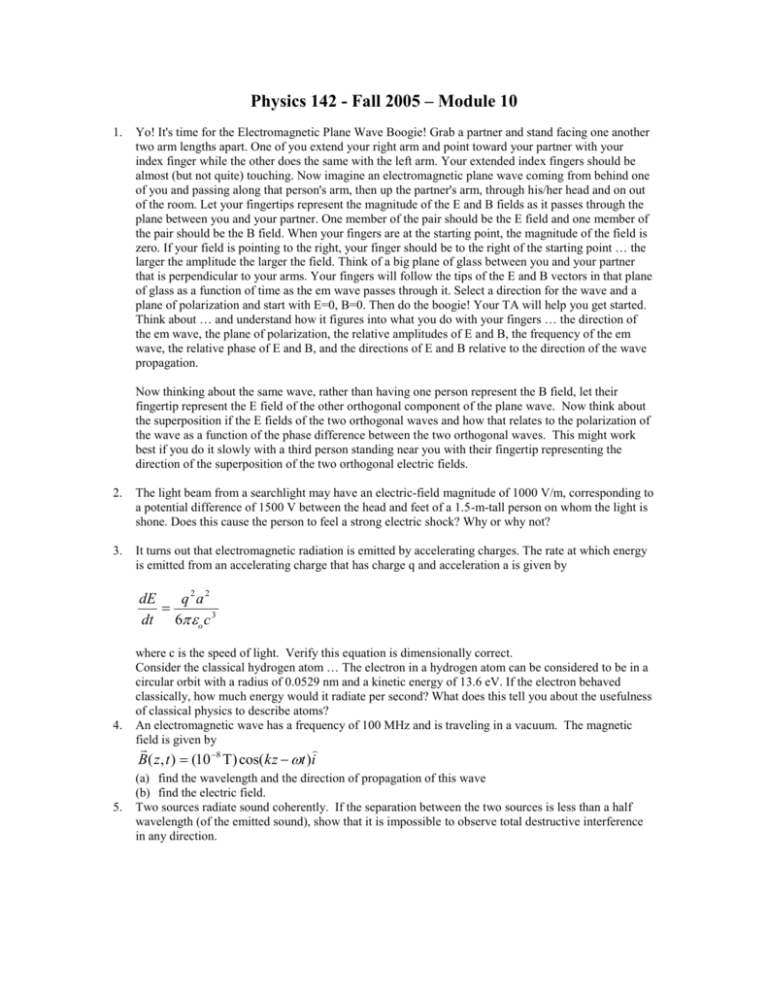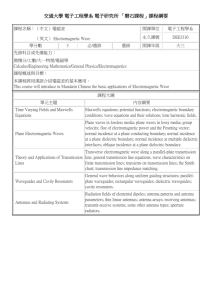Workshop module 9 - Physics 114, Spring 2000
advertisement

Physics 142 - Fall 2005 – Module 10 1. Yo! It's time for the Electromagnetic Plane Wave Boogie! Grab a partner and stand facing one another two arm lengths apart. One of you extend your right arm and point toward your partner with your index finger while the other does the same with the left arm. Your extended index fingers should be almost (but not quite) touching. Now imagine an electromagnetic plane wave coming from behind one of you and passing along that person's arm, then up the partner's arm, through his/her head and on out of the room. Let your fingertips represent the magnitude of the E and B fields as it passes through the plane between you and your partner. One member of the pair should be the E field and one member of the pair should be the B field. When your fingers are at the starting point, the magnitude of the field is zero. If your field is pointing to the right, your finger should be to the right of the starting point … the larger the amplitude the larger the field. Think of a big plane of glass between you and your partner that is perpendicular to your arms. Your fingers will follow the tips of the E and B vectors in that plane of glass as a function of time as the em wave passes through it. Select a direction for the wave and a plane of polarization and start with E=0, B=0. Then do the boogie! Your TA will help you get started. Think about … and understand how it figures into what you do with your fingers … the direction of the em wave, the plane of polarization, the relative amplitudes of E and B, the frequency of the em wave, the relative phase of E and B, and the directions of E and B relative to the direction of the wave propagation. Now thinking about the same wave, rather than having one person represent the B field, let their fingertip represent the E field of the other orthogonal component of the plane wave. Now think about the superposition if the E fields of the two orthogonal waves and how that relates to the polarization of the wave as a function of the phase difference between the two orthogonal waves. This might work best if you do it slowly with a third person standing near you with their fingertip representing the direction of the superposition of the two orthogonal electric fields. 2. The light beam from a searchlight may have an electric-field magnitude of 1000 V/m, corresponding to a potential difference of 1500 V between the head and feet of a 1.5-m-tall person on whom the light is shone. Does this cause the person to feel a strong electric shock? Why or why not? 3. It turns out that electromagnetic radiation is emitted by accelerating charges. The rate at which energy is emitted from an accelerating charge that has charge q and acceleration a is given by dE q2a2 dt 6o c 3 4. where c is the speed of light. Verify this equation is dimensionally correct. Consider the classical hydrogen atom … The electron in a hydrogen atom can be considered to be in a circular orbit with a radius of 0.0529 nm and a kinetic energy of 13.6 eV. If the electron behaved classically, how much energy would it radiate per second? What does this tell you about the usefulness of classical physics to describe atoms? An electromagnetic wave has a frequency of 100 MHz and is traveling in a vacuum. The magnetic field is given by B( z, t ) (10 8 T) cos( kz t )i 5. (a) find the wavelength and the direction of propagation of this wave (b) find the electric field. Two sources radiate sound coherently. If the separation between the two sources is less than a half wavelength (of the emitted sound), show that it is impossible to observe total destructive interference in any direction. 6. Erving Von Humbolt, famed Professor of Pre-Columbian Artifacts has discovered a musical instrument he believes was once used by native peoples in what is now southeast Paraguay for “some serious jammin’, rockin’, and gettin’ down” during adolescent mating rituals. Unfortunately, the instrument he has discovered is broken. He comes to you for help in understanding what sounds the instrument might have made. Please help him out! The instrument has one string. That string is tied at one end and constrained to move freely up and down a thin rod on the other end. Determine the correct expression for the frequency of the n th harmonic of the string in terms of the length (L), tension (T), and the mass/length () of the string. Below are are a few possibilities, one of which is the correct answer. (a) n (b) n T 2L where n=1,3,5 … n n T 2L where n=1,2,3, … (d) n (c) (e) n T 4L where n = 1,3,5, … n n T 4L where n=1,2,3, … n n 2L where n=1,2,3, … gT








